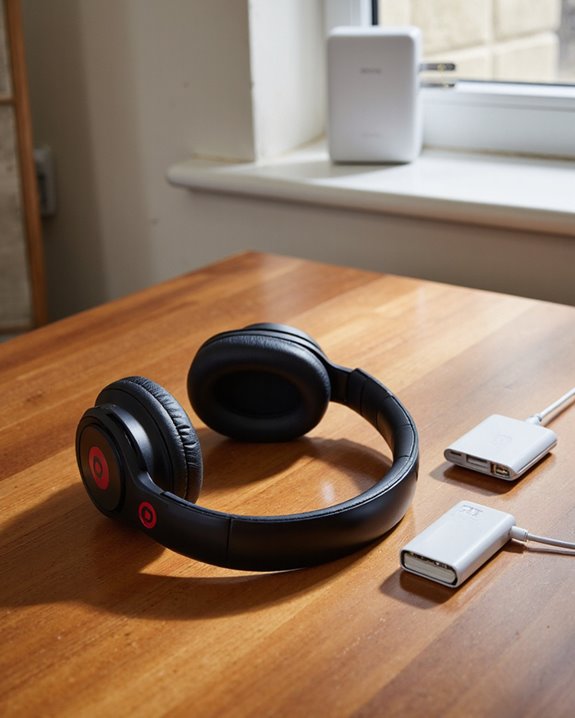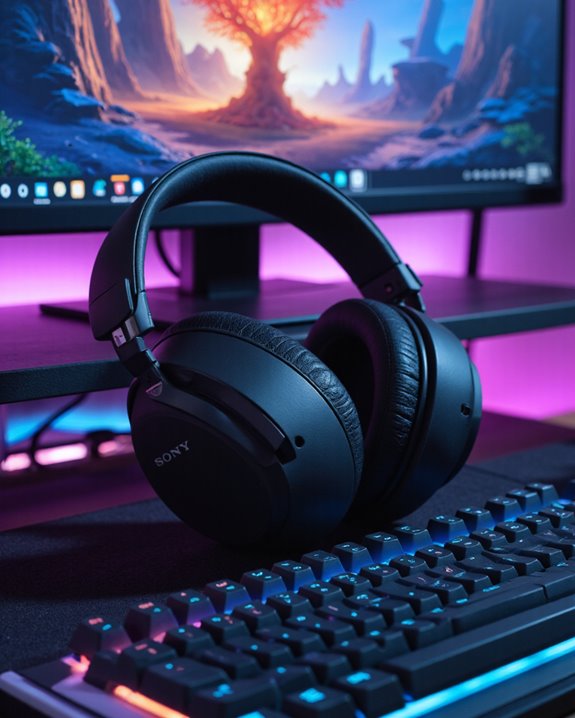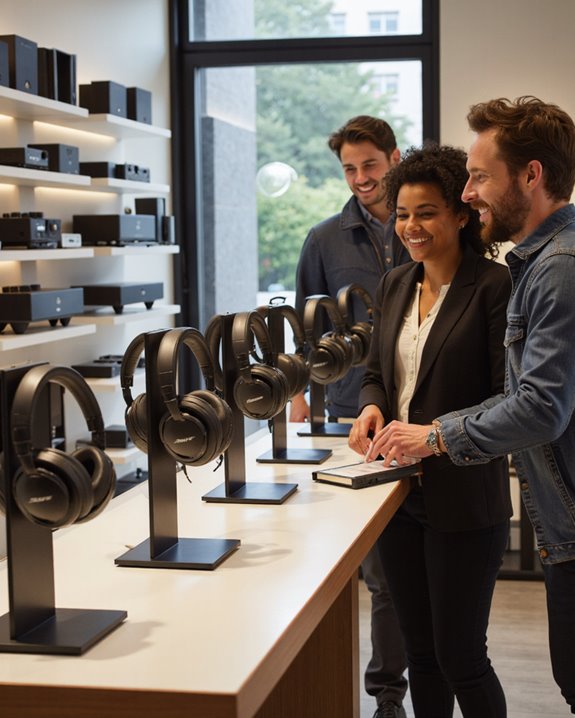As an Amazon Associate, we earn from qualifying purchases. Some links may be affiliate links at no extra cost to you. Although our opinions are based on curated research, we haven't used these products. Articles generated with AI.
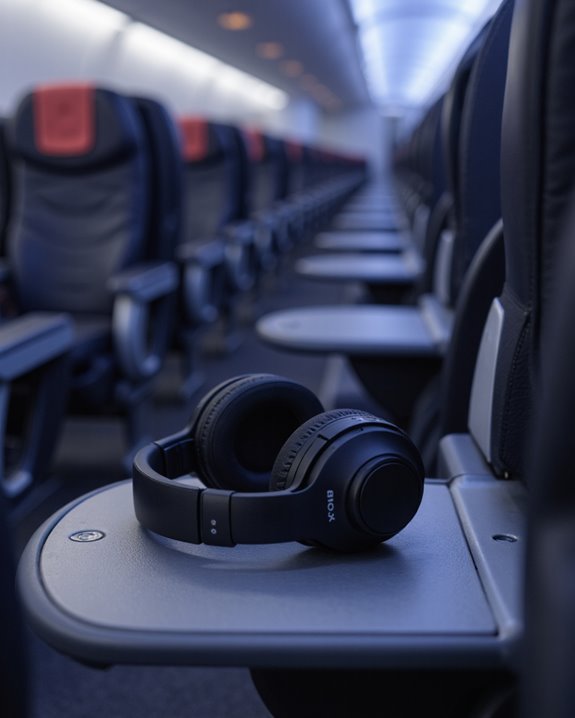
Can You Take Headphones From a Plane?
Whether we can take headphones from a plane depends on the airline’s policy and the type of headset provided. Typically, basic single-use headphones in economy are ours to keep—airlines like Delta make this clear. However, premium or noise-canceling headphones, especially those in business or first class (like Emirates), must be returned for sanitation and reuse. Since policies vary widely, it’s always best to check with flight attendants before disembarking. Further details clarify the differences and best practices for travelers.
Key Takeaways
- Airline policies vary; some allow you to keep headphones, while others require them to be returned at the end of the flight.
- Delta generally permits passengers to take economy class headphones as they are single-use and not reused.
- Emirates and many other airlines collect headphones for cleaning and reuse, so they should not be taken.
- Always check with flight attendants or review airline guidelines to confirm if headphones can be kept.
- Amenity kit headphones are typically yours to keep, but standard in-flight headphones are often airline property.
Airline Policies on In-Flight Headphones
Although most of us have likely wondered about taking in-flight headphones home, airline policies on this topic aren’t universally consistent and depend on several operational factors. Some airlines, such as Delta, allow us to keep the headphones provided during the flight, since these are typically discarded after use. In contrast, carriers like Emirates collect headphones for cleaning and reuse, reflecting sustainability and cost considerations. Most airlines provide headphones to enable access to their in-flight entertainment system, but whether we can retain them varies. Amenity kits, which occasionally include headphones, are generally ours to take. To avoid misunderstandings, it’s always best to check with the airline or ask a flight attendant about their specific policy before assuming we can keep the headphones.
Types of Headphones Provided on Planes

When we’re considering whether we can take headphones from a flight, it’s helpful to first understand the range of headphones airlines provide. On most commercial aircraft, airlines offer complimentary headphones to facilitate access to in-flight entertainment systems. In economy class, these headphones are usually basic, featuring standard stereo sound and a dual-pin aviation adapter. Airlines such as Delta discard economy headsets after use, while carriers like Emirates collect, clean, and reuse them. In premium cabins, higher-quality options—often featuring active noise-canceling technology—are common, enhancing the entertainment experience through reduced cabin noise. Some airlines now provide Bluetooth-compatible headsets, allowing passengers to connect personal devices seamlessly. Given the variability across airlines and aircraft, it’s important to check the airline’s specifications when planning for onboard entertainment.
When You Are Allowed to Take Headphones
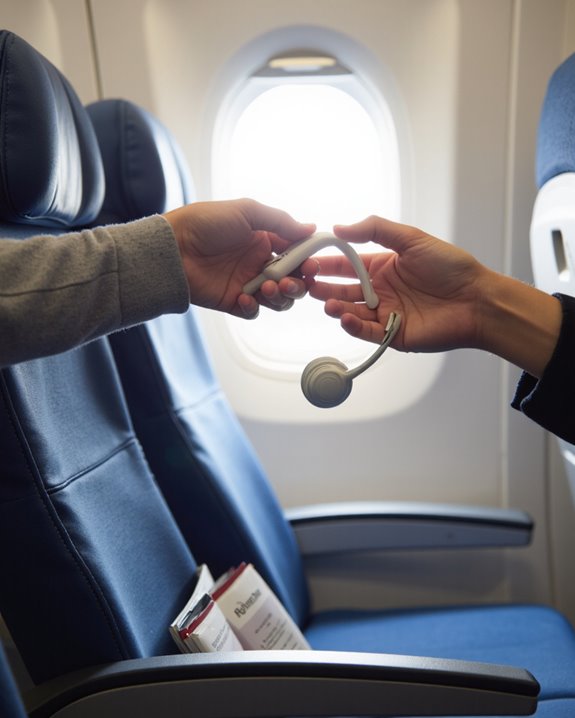
Curiously, determining if we’re allowed to take headphones from a plane hinges on the specific airline’s policy and the class of service we’re flying. Some airlines allow the use of provided headsets beyond the flight, such as Delta, which permits economy-class passengers to keep their headphones because these are discarded after a single use. In contrast, other carriers—like Emirates—ask you to turn in your headset before leaving, as they clean and reuse them for future passengers. Because policies regarding headsets can differ based on both airline and ticket class, it’s essential to inquire with flight attendants before disembarking. Reviewing the airline’s published guidelines ahead of time also helps us avoid misunderstandings about whether we can retain headphones or must leave them behind.
When You Cannot Take Headphones
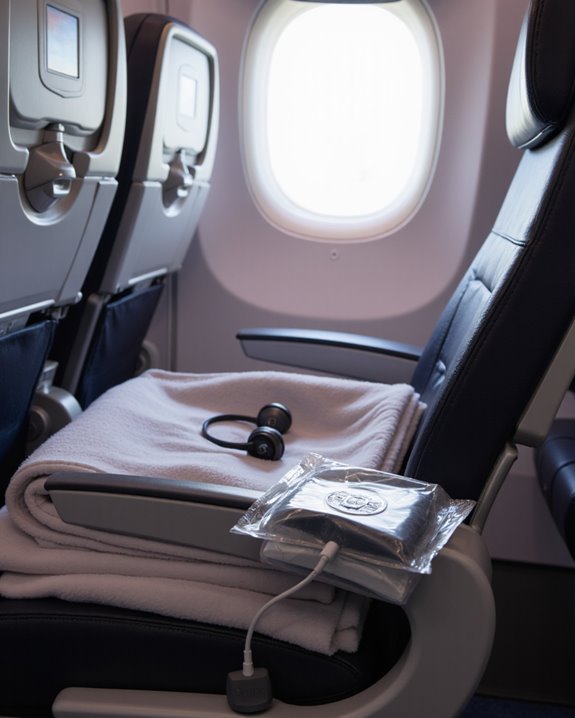
There are clear instances in which we can’t take headphones from a plane, and these are typically outlined in the airline’s onboard procedures. Most airlines, particularly in economy class, collect headphones on a flight at the end of service—these headsets are intended for reuse after proper sanitation. For example, Emirates requires passengers to return headphones, ensuring they’re cleaned and redistributed for subsequent flights. Headphones used for safety announcements or as operational equipment are strictly prohibited from removal; these must remain onboard as per aviation regulations. It’s important to remember that each airline has its own policy, and flight attendants enforce these rules consistently. To avoid confusion, always check with the crew before removing headphones, as keeping them when not permitted may violate airline protocols.
What Happens to Headphones After the Flight
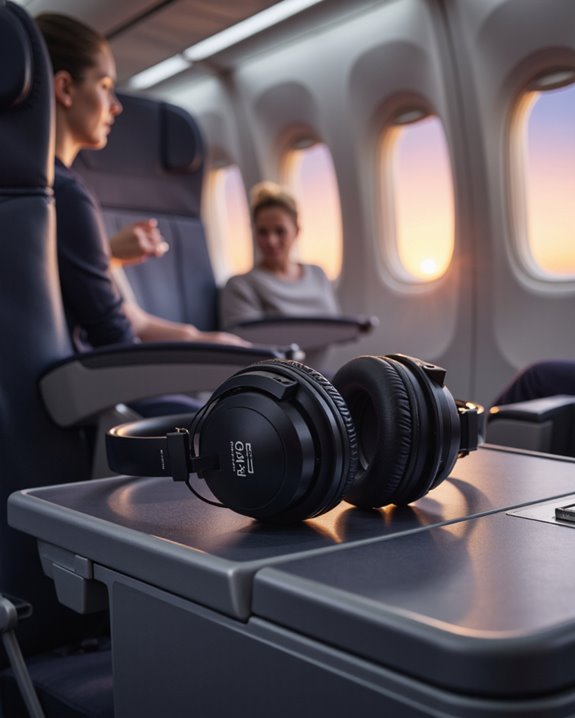
Many airlines follow distinct protocols for handling headphones after a flight, and these processes can vary based on class of service and carrier policies. After landing, most economy class headsets—often lightweight and low-cost—are either collected for disposal or cleaning, depending on the airline’s hygiene standards. For example, Delta typically allows passengers to keep economy headphones, as they’re intended for single use. In contrast, airlines like Emirates retrieve all headsets to be sanitized and reused on subsequent flights, maintaining stricter hygiene controls. These varying policies reflect how airlines balance cost management, sanitation, and resource efficiency. It’s important that we check with flight attendants about airline-specific rules before deplaning, as some carriers enforce collection, while others permit passengers to retain the headphones provided on board.
Differences Between Economy and Premium Cabin Headphones
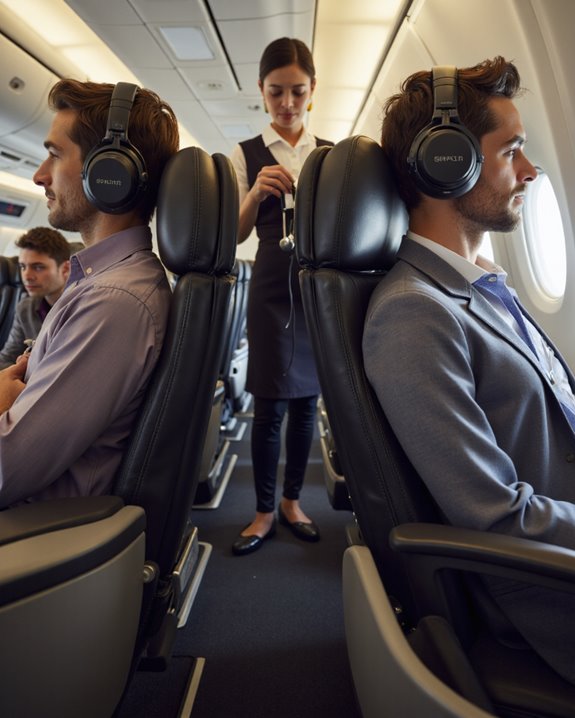
Headphone quality and retention policies differ markedly between economy and premium cabins, reflecting both the airline’s service tier and its approach to in-flight amenities. In economy class, we typically receive basic wired headphones—often lightweight, with minimal padding and limited frequency response—designed primarily for rudimentary in-flight entertainment. These are sometimes collected before landing, though some airlines, like Delta, discard them after use, allowing us to keep them.
In contrast, premium cabin passengers enjoy access to higher-end headphones, frequently featuring active noise-canceling technology, superior sound isolation, and more comfortable ear cushions. These enhancements dramatically improve the in-flight entertainment experience. However, retention policies vary: Emirates collects and sanitizes premium headphones, while other airlines may permit passengers to take them home. We should always verify policies before flying.
Many premium headphones feature noise-canceling microphone technology, which significantly enhances audio clarity for remote communication, a feature increasingly valued beyond just in-flight uses.
Environmental and Hygiene Considerations

While we might not always consider the environmental and hygiene implications of in-flight headphones, airlines employ distinct strategies that directly impact both sustainability and passenger health. For example, Delta discards economy-class headphones after use, permitting us to take them home—this repurposing can help minimize environmental waste compared to immediate landfill disposal. In contrast, Emirates collects, sanitizes, and reuses headsets, underscoring a commitment to hygiene and sustainability through rigorous sanitation protocols. We’re also encouraged to use airline-provided sanitizing wipes and gels, which not only support personal hygiene during the flight but can be retained for continued sanitation afterward. Removal of shared items like bathroom products is discouraged to uphold collective hygiene standards and limit cross-contamination, highlighting our shared responsibility for cabin cleanliness and environmental stewardship.
How to Find Out Your Airline’s Policy
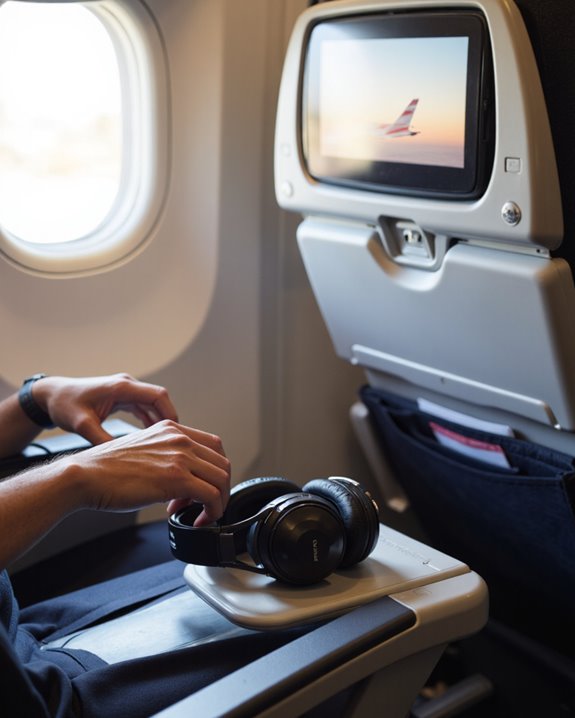
Curious about whether you can take headphones from your flight? Let’s break down how to find out your airline’s policy. First, visit the airline’s official website and navigate to the FAQs—these sections often provide clear, specific information about headsets and other amenities. Policies vary; for instance, Delta may let us keep economy-class headsets, while Emirates typically requires returns for cleaning. If online details are unclear, contacting customer service directly is the next best step. Representatives can clarify whether their policy allows passengers to keep or reuse headsets. Additionally, pay attention to onboard announcements or consult flight attendants before landing, as they’re equipped with up-to-date guidance. Since airline policies may change, verify all information close to your departure date for accuracy.
Alternative Ways to Enjoy In-Flight Entertainment
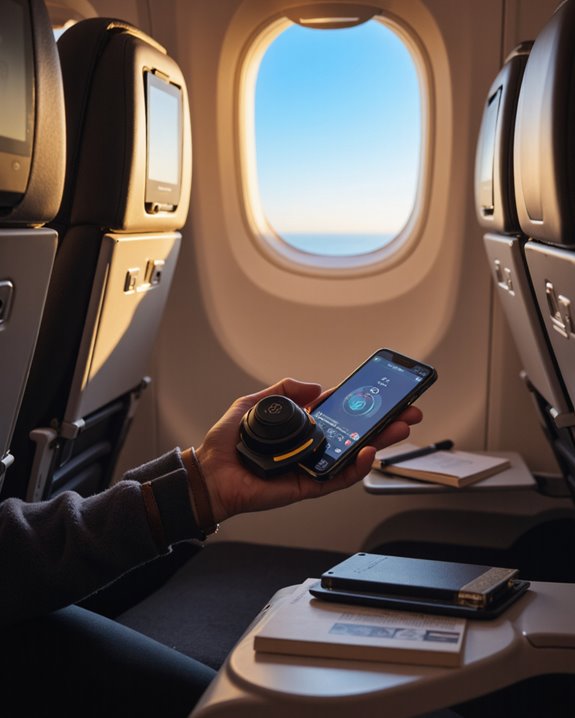
Even if we can’t keep the airline’s headphones, there are several reliable alternatives for enjoying in-flight entertainment without missing out on audio quality or content variety. Most modern airlines feature built-in entertainment systems that support standard 3.5mm wired headphones, ensuring broad compatibility. For those who prefer to use wireless headphones, especially on long-haul flights, Bluetooth adapters (usually 3.5mm plug-in devices) can bridge the gap between wired outputs and Bluetooth audio. Alternatively, downloading movies, shows, or music onto our smartphones or tablets before boarding allows us to use Bluetooth headphones directly, bypassing airline systems entirely. Many carriers also provide onboard streaming services accessible via personal devices—letting us enjoy content with our own headphones. Noise-canceling models can further enhance immersion, reducing cabin noise considerably. Choosing earbuds with Bluetooth 5.2 connectivity ensures stable wireless performance and better range on flights.
Tips for Bringing Your Own Headphones on Board
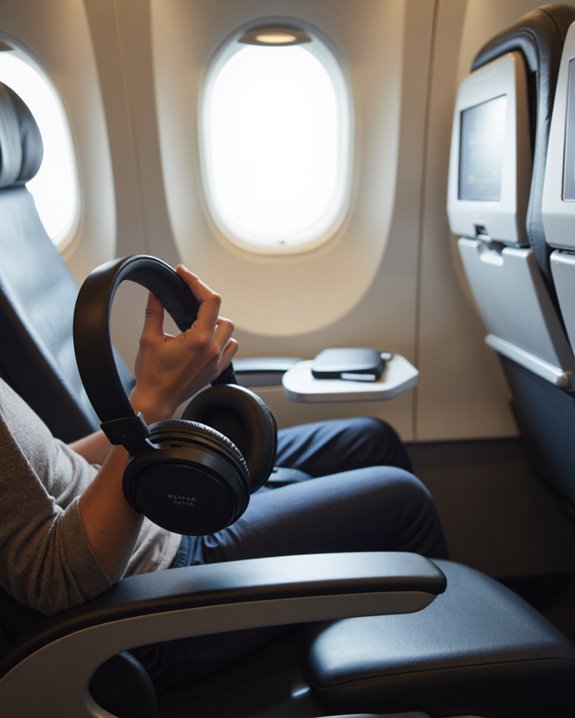
Although it’s increasingly common for airlines to support passengers using their own headphones, preparing in advance guarantees we get the best possible in-flight listening experience.
Preparing Your Headphones for Air Travel
First, let’s confirm compatibility. Many in-flight entertainment systems still require a standard 3.5mm jack, so if we plan to use Bluetooth headphones, packing a Bluetooth-to-jack adapter is essential—especially on older aircraft. Fully charging our headphones before boarding is wise, as in-seat charging may be unavailable. Adjusting our devices settings to airplane mode with Bluetooth enabled (where permitted) assures compliance and functionality. For important announcements, airlines may require us to remove headphones or lower the volume, so it’s best to remain attentive. Finally, reviewing airline-specific policies on headphone use and connectivity options before departure helps us avoid unexpected issues and assures a seamless, enjoyable flight experience. Many top headphones now feature Bluetooth 5.3 connectivity, offering longer range and more stable connections even in busy environments like airplanes.
Frequently Asked Questions
Can You Take the Headphones From the Plane?
Just like checking if you can take hotel slippers home, we should know in flight etiquette and headphone policies. Airline regulations differ—some let us keep them, others don’t. Always ask; passenger rights depend on each airline’s rules.
Can You Take Headphones Through Airport Security?
When we go through airport security, we can bring headphones as they’re allowed under current airport security procedures and electronic device policies. Let’s keep them accessible for screening, follow personal item regulations, and remember these travel accessory tips for smooth travel.
Can I Bring My Own Headphones on a Plane?
Let’s hit the skies with our favorite headphones—it’s smooth sailing when we enjoy noise cancelling benefits or the convenience of wireless headphones. Remember airplane etiquette tips and check compatibility issues with in-flight systems for a seamless experience.
Do Headphones Count as a Personal Item?
When we consider headphone regulations and personal item policies, headphones typically count as a personal item. They’re allowed for in flight usage, adding travel convenience, but let’s always check our airline’s specific rules before packing them.

